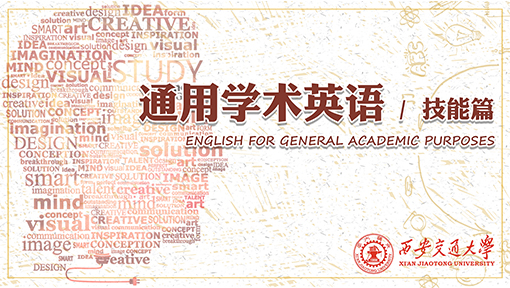
当前课程知识点:Skills in English for General Academic Purposes > Unit 17 Basic Structure of a Research Article > Supplementary Materials > Paper in lecture
返回《Skills in English for General Academic Purposes》慕课在线视频课程列表
该文章是授课中老师最后布置作业时提到的论文,供大家阅读和练习:
A Scale for Measuring Attitude toward Cheating
INTRODUCTION
Academic ability and academic honesty are two of the most important and desirable characteristics of college students. There exist reams of research on ability, including a host of standardized tests of aptitude and achievement. In contrast, there is a dearth of research on academic honesty. Since measurements of academic honesty are typically determined by incidents of cheating, confidentiality and ethical considerations pose problems for the researcher.
Given the difficulties of directly studying classroom cheating, researchers have tended to investigate other variants of veracity. For example, cheating by children has been studied through the use of games, a word-construction task, and workbook mathematics problems. With college students, researchers have used anonymous questionnaires to investigate data fabrication in self-modification projects. Another method has been through the use of a test in a laboratory setting combined with a “found” answer key.
Barlow (1967) analyzed students’ cheating through the use of a programmed book that inadvertently contained two inappropriate answers. In the present study, we used a more systematic variant of this method in conjunction with a study guide. Along with difficulties in measuring observable cheating, there is no valid standardized scale of attitude toward cheating. An early attempt to construct such a scale (Mills, 1958) was not successful.
The present research addresses two issues: (1) the development of a systematic approach to measure cheating on study guide assignments, and (2) the development and validation of a standardized attitude toward cheating (ATC) scale .
METHOD
The ATC scale was administered to 42 students enrolled in two introductory psychology courses during a summer semester at Jacksonville State University (JSD). During the first class day, the students were asked to complete the “Opinion Questionnaire” (i.e., the ATC scale). A blank was provided at the end of the questionnaire for the student number. The students were told that the questionnaire was part of a research project and that answering it was totally voluntary. All 42 students completed the questionnaire, but 8 subjects did not give their student numbers.
One hundred five copies of the questionnaire were distributed to four JSU deans. The deans were requested to distribute the copies to as many of their faculty members as possible and to ask them to mail the completed forms back to the psychology department. Completed ATCs were returned by 50 faculty members.
ATC Scale Construction
In the construction of the ATC scale, efforts were made to sample attitudes along the continuum of equivocal to unequivocal incidents of cheating. Some selected items addressed contingencies placed on cheating, whereas other items dealt with specific instances that may or may not be regarded as cheating. Some items assessed attitude toward the cheater, toward the morality of cheating, and toward the teacher's behavior. An item analysis was performed using data from 42 students and 50 faculty.
Fourteen of the 34 items condemned cheaters. These items were interspersed among 20 items that expressed tolerance for cheaters.
Because cheating is generally regarded in a negative fashion, students may tend to conceal their true feelings. To promote objectivity and honesty, items were worded without reference to the readers; that is, no items used personal pronouns. Thus, the readers were not put on the defensive by any statements concerning their own behavior; rather their attitudes were inferred from their judgments of the behavior of others.
Measurement of Cheating
A study guide designed to detect cheating was required in the two courses in which the subjects were enrolled. About 20% of the answers in the answer list in the back of the study guide were deliberately worded differently from the textbook. This allowed assessment of the degree to which the students obtained answers from the answer list in cheating.
The keyed answers were worded differently in some insignificant ways from the wording in the textbook. These wording variations included alterations in word order, substitution of synonyms, and additional insignificant words .
Answers on keyed questions were checked. For three to six keyed questions in each chapter assignment, wording agreement between the student's answer and the wording of the answer list was scored as cheating. The students were given an overall score consisting of the number of questions cheated on divided by the total number of questions completed. This score was averaged across four equal time periods to get the mean cheating rate.
RESULTS
Construct Validity
We expected that faculty members would hold more intolerant (or condemnatory) views on cheating and would, therefore, score higher than students on the ATC scale, if the scale validly measured attitude toward cheating. A one-way analysis of variance (ANOVA) revealed that the 50 faculty members scored significantly higher (M = 25.02, SD = 12.60) than the 42 students (M = 15.76, SD = 13.19) on the ATC scale [F(1,91) 11. 72 , p < .0 1].
Predictive Validity
Condemnatory attitudes toward cheating (i.e., high ATC scores) should be inversely related to actual cheating, presuming that a relationship exists between the attitude (verbal reference) and the referent behavior. The correlation coefficient (r) between ATC scores and mean cheating rates was -.30 (p < .05, one-tailed) for the 34 students who identified their questionnaires by student number.
Analysis of Faculty/Student Differences
Faculty and student means were significantly different for eight items on the questionnaire, five of which dealt with enforcement of honesty, a primary concern of instructors.
Predictably, teachers saw cheaters as more unethical than did students. More students than teachers rated getting a degree as the main purpose of going to college. However, teachers saw students as more honest than did the students themselves.
DISCUSSION
The ATC scale proved to be a reliable measure of attitude toward cheating. More importantly, the scale was shown to have construct validity. As expected, the students’ ATC scores indicated that they tended to be more tolerant of cheating than were faculty members.
Mills (1958) constructed a 14-item questionnaire to measure attitude toward cheating. Unfortunately, this scale did not correlate significantly with actual cheating. The 34-item ATC scale described in the present study, however, was predictive of cheating. Although the correlation between ATC scores and cheating rates was not high (r= -.30), the upper limit of this predictive validity coefficient is set by the correlation between the true scores for the two variables, attitude toward cheating and actual cheating; that is, someone may cheat even though he/she may be intolerant of cheaters, or, conversely, someone may refrain from cheating but still be tolerant of others who cheat. Furthermore, the observed correlation between ATC scores and cheating rates is comparable to many validity coefficients reported in the literature on predictive validity (Schmitt, Gooding, Noe, & Kirsch, 1984).
The study guide by Gardner and Roper (1986), which was specifically designed to detect cheating, offers a new technology for direct assessment of academic honesty. To ensure high rates of cheating, our students were not threatened with penalties for cheating on their study guide work. Cheating levels were, in fact, very high. Examining the research on academic honesty, our task seems closest to those used by Barton (1982) and Worthington (1977). They studied the falsification of self-modification data - also a widespread (75%) occurrence. The advantage of having high rates of cheating (for research purposes) is the increased measurement sensitivity. We conclude that this study guide technique has potential in the assessment of academic honesty .
REFERENCES
BARWW, J.A. (1967). Note: Student cheating in studying programmed material. Psychological Record, 17, 515-516 .
SCHMITT, N., GOODING, R. Z., NOE, R. A., & KIRSCH, M. (1984). Meta-analyses of validity studies published between 1964 and 1982 and the investigations of study characteristics. Personnel Psychology, 37,407-421.
返回《Skills in English for General Academic Purposes》慕课在线视频列表
-Video Course
--Unit 1 How to write an argumentative essay?
-Word Bank
-Discussion Question
-Quiz
--Unit 1 How to Write an Argumentative Essay?
-Supplementary Materials
-Video Course
-Word Bank
-Discussion Question
-Quiz
--Unit 2 How to Paraphrase?
-Supplementary Materials
-Video Course
-Word Bank
-Discussion Question
-Quiz
--Unit 3 How to Write an Essay by Classification?
-Supplementary Materials
-Video Course
--Macrostructure of Academic Lectures
-Word Bank
-Discussion Question
-Quiz
--Unit 4 Macrostructure of Academic Lecture
-Supplementary Materials
--Video--How plants defend themselves
-Video Course
-Word Bank
-Discussion Question
-Quiz
--Unit 5 How to Write a Definition?
-Supplementary Materials
--Video--short-term and long-term memory
-Video Course
-Word Bank
-Discussion Question
-Quiz
--Unit 6 How to Describe a Concept?
-Supplementary Materials
--Video--what is verbal irony?
-Video Course
-Word Bank
-Discussion Question
-Quiz
-- Unit 7 How to Write an Essay by Comparison and Contrast?
-Supplementary Material
--Comparison of two scientists
-Video Course
--How to Raise Questions like Socrates
-Word Bank
-Discussion Question
-Quiz
--Unit 8 How to Raise Questions like Socrates?
-Supplementary Materials
-Video Course
-Word Bank
-Discussion Question
-Quiz
--Unit 9 How to Write a Cause-and-Effect Essay?
-Supplementary Materials
-Video Course
-Word Bank
-Discussion Question
-Quiz
--Unit 10 How to Present a Graph?
-Supplementary Materials
--Video--how to describe diagrams?
-Video Course
-Word Bank
-Discussion Question
-Quiz
--Unit 11 Process Writing
-Supplementary Materials
--Sample writing (IELTS writing)
-Video Course
-Word Bank
-Discussion Question
-Quiz
--Unit 12 Listening Between the Lines
-Supplementary Materials
-Video Course
-Word Bank
-Discussion Question
-Quiz
--Unit 13 How to Write a Summary?
-Supplementary Materials
--Video---how to write a summary
--Sample 2
-Video Course
--Taking Notes in Lecture Listening
-Word Bank
-Discussion Question
-Quiz
--Unit 14 Taking Notes in Lecture Listening
-Supplementary Materials
--Video--how best listening to lectures
-Video Course
-Word Bank
-Discussion Question
-Quiz
--Unit 15 A Reading Method--SQ3R
-Supplementary Material
-Video Course
-Word Bank
-Discussion Question
-Quiz
--Unit 16 How to Distinguish Fact and Opinion?
-Supplementary Material
-Video Course
--Basic Structure of Academic Lectures
-Word Bank
-Discussion Question
-Quiz
--Unit 17 Basic Structure of a Research Article
-Supplementary Materials
--How to structure research articles?
-Video Course
-Word Bank
-Discussion Question
-Quiz
--Unit 18 Citations and References
-Supplementary Materials
--Reference and Citation Format
-Video Course
--How to Support Your Claim Effectively in Speaking
-Word Bank
-Discussion Question
-Quiz
--Unit 19 How to Argue Effectively in Speaking
-Video Course
-Word Bank
-Discussion Question
-Quiz
--Unit 20 Hedging in Academic Writing
-Video Course
--Three Minute Thesis Presentation
-Word Bank
-Discussion Question
-Quiz
--Unit 21 Three Minute Thesis Presentation
-Video Course
--How to Get Topic of Lecture Listening
-Word Bank
-Discussion Question
-Quiz
--Unit 22 How to Get the Topic in Lecture Listening
-Supplementary Materials
-Video Course
--How to Write a Personal Statement
-Word Bank
-Discussion Question
-Quiz
--Unit 23 How to Write a Personal Statement
-Supplementary Materials
-Final Exam
--Final Exam--期末考试



